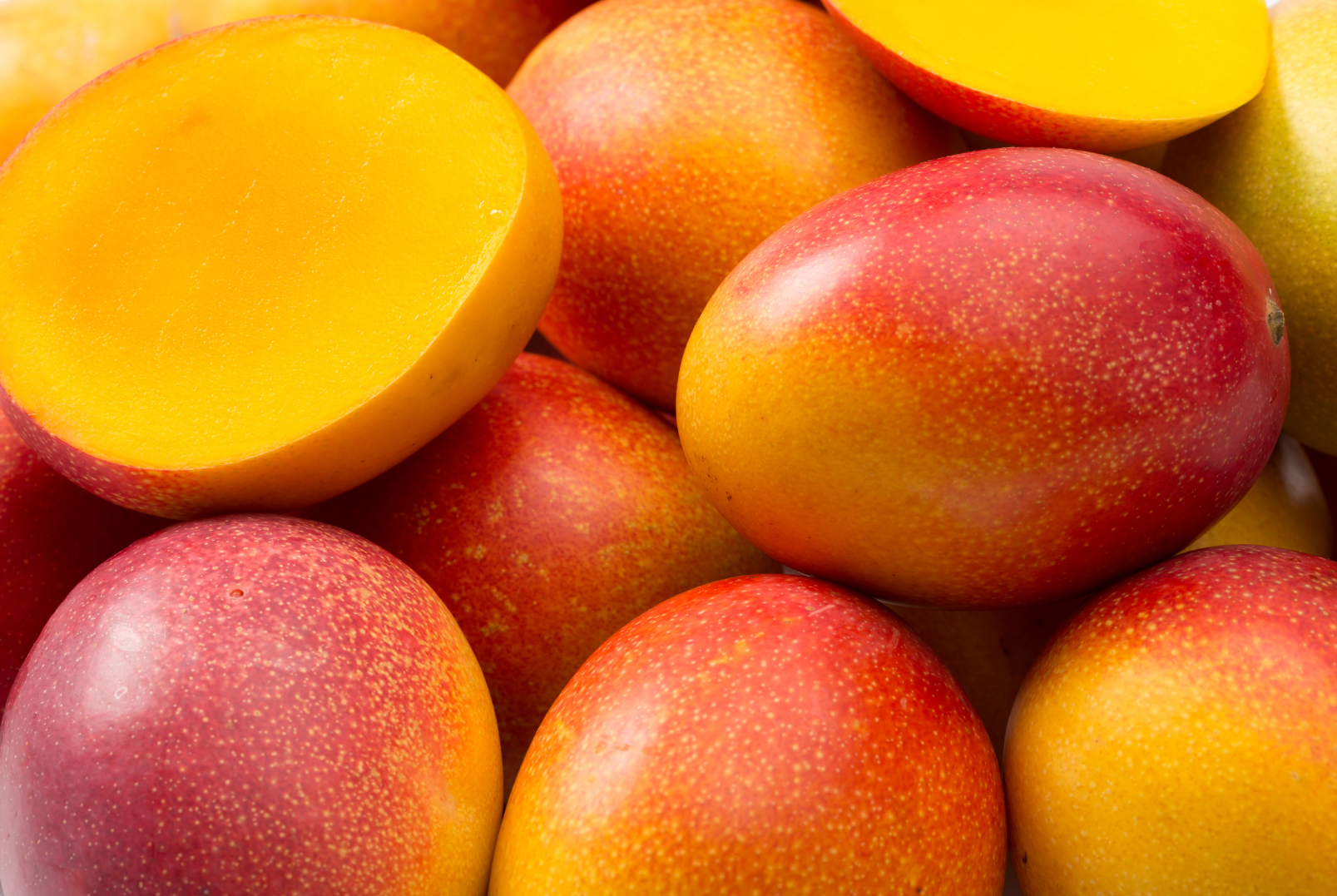Valor nutricional del mango y beneficios para la salud

Este artículo también está disponible en los siguientes idiomas:
Este artículo también está disponible en los siguientes idiomas:
![]() English (Inglés)
English (Inglés) ![]() Français (Francés)
Français (Francés) ![]() Deutsch (Alemán)
Deutsch (Alemán) ![]() हिन्दी (Hindi)
हिन्दी (Hindi) ![]() العربية (Árabe)
العربية (Árabe) ![]() Ελληνικά (Griego)
Ελληνικά (Griego)
Muchos consideran que el mango es el “rey” de las frutas ya que lo podemos consumir fresco y utilizarlo para elaborar postres, zumos de fruta y mermeladas. Además, es fuente de vitaminas A, B, y C, azúcar, carbohidratos, proteína, grasas, fibra, agua, etc.
Según datos de la USDA, un mango (336 g) contiene:
- Energía: 202 kcal – 840 kJ
- Agua: 281 g
- Proteínas: 2,76 g
- Fibra: 5,38 g
- Azúcares: 46 g
- Potasio: 564 mg
- Calcio: 37 mg
- Fósforo 47 mg
- Magnesio: 33,6 mg
- Hierro: 0,538 mg
- Carotenoides: 61 mg
El mango contiene algunas trazas de selenio, cobre, zinc y manganeso. En cuanto a las vitaminas, contiene 122 mg de vitamina C (más del 50% de la ingesta diaria recomendada (IDR), 181 μg de vitamina A y 3,02 mg de vitamina E.
Además de ser una fruta deliciosa, consumir mango puede tener beneficios en la salud del ser humano. Puede:
- Reducir el riesgo de padecer cáncer (de colon, de mama, leucemia y de próstata).
- Reforzar el sistema inmunológico gracias a sus antioxidantes (beta-caroteno) y altos niveles de vitaminas C y A.
- Reducir el colesterol gracias a sus grandes niveles de fibra y vitamina C.
- Mejorar la salud de los ojos y de la piel, así como la digestión.
- Ayudar a prevenir la anemia.
- Favorecer la salud del corazón (sistema cardiovascular) y reducir la tensión arterial.
A pesar de sus numerosos beneficios para la salud, tal y como sucede con cualquier otro alimento, debemos consumir mango de forma racional. Aunque se han dado muy pocos casos de respuestas alérgicas, es mejor pelar la fruta y no consumir la piel ya que contiene pequeñas cantidades de urushiol.
Referencias
https://fdc.nal.usda.gov/fdc-app.html#/food-details/169910/nutrients
Find more information in the book: “Success in Agribusiness: Growing Mango successfully” written by James Mwangi Ndiritu
Codex Alimentarius Commission. General Principles of Food Hygiene CXC 1-1969. 2021.
De Graaf J. Developing a Systems Approach for Sternochetus mangiferae (Coleoptera: Curculionidae) in South Africa. J Econ Entomol. 2010; 103(5):1577–85.
Dias, C.S.; Rodrigues, R.G.; Ferreira, J.J. What’s new in the research on agricultural entrepreneurship? J. Rural. Stud. 2019, 65, 99–115.
FAO. The Future of Food Safety; FAO: Rome, Italy, 2019.
Grové T, De Beer MS, Daneel MS, Steyn WP. Scale and mealybug survey on mango in Mpumalanga and Limpopo Provinces South Africa. Acta Hortic. 2013; 1007:377–84.
Grové T, De Villiers EA, Daneel MS. Mango. In: Prinsloo GL, Uys VM, editors. Insects of cultivated plants and natural pastures in Southern Africa. Pretoria: Entomological Society of Southern Africa; 2015a. p. 574–88.
Grové T, De Villiers EA, Schoeman PS. Litchi. In: Prinsloo GL, Uys VM, editors. Insects of cultivated plants and natural pastures in Southern Africa. Pretoria: Entomological Society of Southern Africa; 2015b. p. 554–9.
Grové T, De Beer MS, Joubert PH. Monitoring fruit flies in mango orchards in South Africa and determining the time of fruit infestation. Acta Hortic. 2009; 820:589–96. .
Grové T, De Beer MS. Insect pests affecting the production of mango in South Africa. Acta Hortic. 2017b; 1183:297–304.
Grové T, De Beer MS. Species composition and abundance of fruit flies (Diptera: Tephritidae) in subtropical fruit orchards in the Mbombela Local Municipality South Africa. Fruits. 2019; 74(1):18–24
Haran J, Grové T, Van Noort S, Benoit L, Addison P. Natural biocontrol of fruit flies in indigenous hosts: A perspective for population control in the agroecosystem. Biol Control. 2019; 137:1–6.
Henri, D. C., Jones, O., Tsiattalos, A., Thebault, E., Seymour, C. L., van Veen, F. J. F. F., et al. (2015). Natural vegetation benefits synergistic control of the three main insect and pathogen pests of a fruit crop in southern Africa. J. Appl. Ecol. 52, 1092–1101.
Hill MP, Macfadyen S, Nash MA. Broad spectrum pesticide application alters natural enemy communities and may facilitate secondary pest outbreaks. PeerJ. 2017; 19(5):e4179.
Joubert PH, Daneel MS, Grové T. Progress towards Integrated Pest Management (IPM) on mangoes in South Africa. Acta Hortic. 2000;509:811–8.
Joubert E, Grové T, Booysen G. Evaluation of fruit fly (Diptera: Tephritidae) monitoring systems on mango in Limpopo Province South Africa. J Agric Sci Technol. 2015;B5:653–63.
Louw CE. The mango seed weevil, Sternochetus mangiferae (Fabricius) (Coleoptera: Curculionidae); understanding the pest in order to ensure effective control measures. Acta Hortic. 2013;992:441–57.
Louw E. Evaluation on the efficacy of different chemicals on gall fly larvae in mangoes. Subtrop Fruit J. 2021;30:18–20.
Kibira, M., Affognon, H., Njehia, B., Muriithi, B., Mohamed, S., and Ekesi, S. (2015). Economic evaluation of integrated management of fruit fly in mango production in Embu County, Kenya. Afric. J. Agric. Resour. Econ. 10, 343–353
King, T.; Cole, M.; Farber, J.M.; Eisenbrand, G.; Zabaras, D.; Fox, E.M.; Hill, J.P. Food safety for food security: Relationship between global megatrends and developments in food safety. Trends Food Sci. Technol. 2017, 68, 160–175.









































































